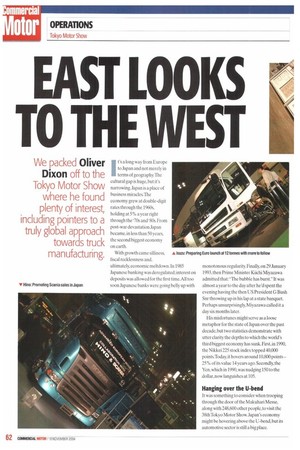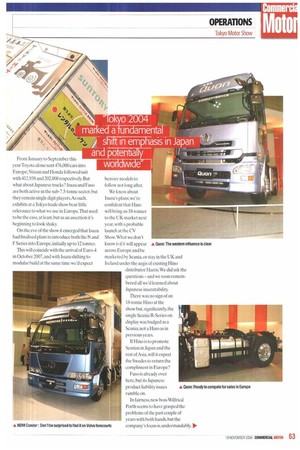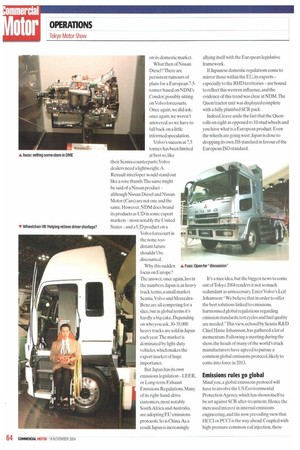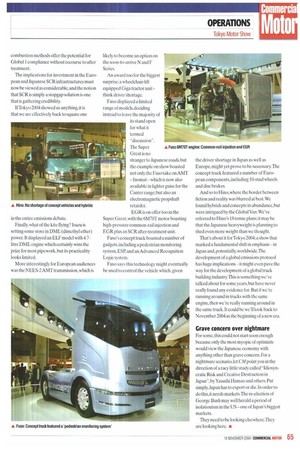EAST LOOKS TO THE WEST
Page 62

Page 63

Page 64

Page 65

If you've noticed an error in this article please click here to report it so we can fix it.
We packed Oliver Dixon off to the
Tokyo Motor Show where he found plenty of interest, including pointers to a truly global approach towards truck manufacturing.
It's a long way from Europe to Japan and not merely in terms of geography.The cultural gap is huge, but it's narrowing. Japan is a place of business miracles.The economy grew at double-digit rates through the 1960s, holding at 5% a year right through the '70s and `80s. From post-war devastation Japan became, in less than SO years. the second biggest economy on earth.
With growth came silliness, fiscal recklessness and, ultimately, economic meltdown. In 1985 Japanese banking was deregulated; interest on deposits was allowed for the first time-All too soon Japanese banks were going belly up with monotonous regularity. Finally, on 29 January 1993, then Prime Minister Kiehl Miyazawa admitted that: "The bubble has burst." It was almost a year to the day after he'd spent the evening having the then US President G Bush Snr throwing up in his lap at a state banquet. Perhaps unsurprisingly, Miyazawa called it a day six months later.
His misfortunes might serve as a loose metaphor for the state of Japan over the past decade, but two statistics demonstrate with utter clarity the depths to which the world's third biggest economy has sunk.First,in 1990, the Nikkei 225 stock index topped 40,000 points.Today, it hovers around 10,800 points — 25% of its value 14 years ago. Secondly, the Yen, which in 1990, was nudging 150 to the dollar, now languishes at 105.
Hanging over the U-bend
It was something to consider when trooping through the door of the Makuhari Messe, along with 248,600 other people, to visit the 38th Tokyo Motor Show. Japan's economy might be hovering above the U-bend, but its automotive sector is still a big place. From January to September this year Toyota alone sent 476,000 cars into Europe; Nissan and Honda followed suit with 412,938 and 202,008 respectively. B ut what about Japanese trucks? Isuzu and Fuso are both active in the sub-7.5-tonne sector, but they remain single digit players.As such, exhibits at a Tokyo trade show bear little relevance to what we use in Europe.That used to be the case, at least, but as an assertion it's beginning to look shaky.
On the eve of the show it emerged that lsuzu had finalised plans to introduce both the N and F Series into Europe, initially up to 12 tonnes.
This will coincide with the arrival of Euro-4 in October 2007, and with Isuzu shifting to modular build at the same time we'd expect heavier models to follow not long after.
We know about Isuzu's plans; we're confident that Hino will bring an 18-tonner to the UK market next year, with a probable launch at the CV Show What we don't know is if it will appear A Oman: The western influence is clear across Europe and be marketed by Scania, or stay in the UK and Ireland under the aegis of existing Hino distributor Harris. We did ask the questions— and we soon remem bered all we'd learned about Japanese inscrutability.
There was no sign of an 18-tonne Hino at the show but,significantly, the single Scania R-Series on display was badged as a Scania; not a Hino as in previous years.
If Hino is to promote Scanias in Japan and the rest of Asia, will it expect the Swedes to return the compliment in Europe?
Fuso is already over here, but its Japanese product liability issues rumble on.
In fairness, new boss Wilfried Forth seems to have grasped the problems of the past couple of years with both hands,but the company's focus is, understandably, 10. on its domestic market.
What then of Nissan Diesel? There are persistent rumours of plans for a European 7.5tonner based on NDM's Condor; possibly sitting on Volvo forecourts. Once again, we did ask; once again, we weren't answered,so we have to fall back on a little informed speculation.
Volvo's success at 7.5 tonnes has been limited at best so, like their Scania counterparts, Volvo dealers need a lightweight.A Renault interloper would stand out like a sore thumb.The same might be said of a Nissan product — although Nissan Diesel and Nissan Motor (Cars) are not one and the same.However,NDM does brand its products as UD in some export markets —most notably the United States — and a UD product on a Volvo forecourt in the none-toodistant future shouldn't be discounted.
Why this sudden focus on Europe? The answer, once again, lies in the numbers. Japan is, in heavy truck terms, a small market. Scania,Volvo and MercedesBenz are all competing for a slice, but in global terms it's hardly a big cake. Depending on who you ask,30-35,000 heavy trucks are sold in Japan each year:The market is dominated by light-duty vehicles, which makes the export market of huge importance.
But Japan has its own emissions legislation —LEER, or Long-term Exhaust Emissions Regulations. Many of its right-hand-drive customers, most notably SouthAfrica and Australia, are adopting EU emissions protocols. So is China. As a result Japan is increasingly allying itself with the European legislative framework.
If Japanese domestic regulations come to mirror those within the EU, its exports — especially to the RHD territories— are bound to reflect this western influence, and the evidence of this trend was clear at NDM.The Quon tractor unit was displayed complete with a fully plumbed SCR pack.
Imleed,leave aside the fact that the Quon rolls on eight as opposed to 10-stud wheels and you have what is a European product. Even the wheels are going west: Japan is close to dropping its own JIS standard in favour of the European ISO standard.
It's a nice idea, but the biggest news to come out of Tokyo 2004 renders it not so much redundant as unnecessary. Enter Volvo's Leif Johansson:" We believe that in order to offer the best solutions linked to emissions, harmonised global regulations regarding emission standards, test cycles and fuel quality are needed."This view, echoed by Scani a R&D Chief Hasse Johansson,has gathered a lot of momentum. Following a meeting during the show, the heads of many of the world's truck manufacturers have agreed to pursue a common global emissions protocol, likely to come into force in 2013.
Emissions rules go global
Mind you, a global emissions protocol will have to involve the US Environmental Protection Agency, which has shown itself to be set against SCR after-treatment. Hence the increased interest in internal emissions engineering, and the now prevailing view that HCCI or PCCI is the way ahead. Coupled with high-pressure common-rail injection, these combustion methods offer the potential for Global I. compliance without recourse to after treatment.
The implications for investment in the European and Japanese SCR infrastructures must now be viewed as considerable, and the notion that SCR is simply a stopgap solution is one that is gathering credibility.
If Tokyo 2004 showed us anything, it is that we are effectively back to square one in the entire emissions debate.
Finally, what of the kite flying? Isuzu is setting some store in DME (dimethyl ether) power. It displayed an ELF model with 4.7litre DME engine which certainly wins the prize for most pipework, but its practicality looks limited.
More interestingly for European audiences was the NEES-2 AMT transmission, which is likely to become an option on the soon-to-arrive N and F Series.
An award too for the biggest surprise: a wheelchair-lift equipped Olga tractor unit think driver shortage.
Fuso displayed a limited range of models, deciding instead to leave the majority of its stand open for what it termed "discussion". The Super Great is no stranger to Japanese roads, but the example on show boasted not only the Fuso take on AMT — Inomat — which is now also available in lighter guise for the Canter range; but also an electromagnetic propshaft retarder.
EGR is on offer too in the Super Great, with the 6M7OT motor boasting high-pressure common-rail injection and EGR plus an SCR after-treatment unit.
Fuso's concept truck boasted a number of gadgets, including a pedestrian monitoring system, ESP, and an Advanced Recognition Logic system.
Fuso says this technology might eventually be used to control the vehicle which, given the driver shortage in Japan as well as Europe. might yet prove to be necessary. The concept truck featured a number of European components, including 10-stud wheels and disc brakes.
And so to Hino, where the border between fiction and reality was blurred at best.We found hybrids and concepts in abundance, but were intrigued by the Global Van. We've referred to Hino's 18 tonne plans; it may be that the Japanese heavyweight is planning to shed even more weight than we thought.
That's about it for Tokyo 2004; a show that marked a fundamental shift in emphasis—in Japan and, potentially, worldwide.The development of a global emissions protocol has huge implications —it might even pave the way for the development of a global truck building industry.This is something we've talked about for some years, but have never really found any evidence for. But if we're running around in trucks with the same engine, then we're really running around in the same truck. It could be we'll look back to November 2004 as the beginning of a new era.
Grave concern over nightmare For some, this could not start soon enough because only the most myopic of optimists would view the Japanese economy with anything other than grave concern. For a nightmare scenario, let CM point you in the direction of a racy little study called "Idiosyncratic Risk and Creative Destruction in Japan", by Yasushi Hamao and others. Put simply, Japan has to export or die. In order to do this, it needs markets.The re-election of George Bush may well herald a period of isolationism in the US —one of Japan's biggest markets.
They need to be looking elsewhere.They are looking here. •
























































































































































































